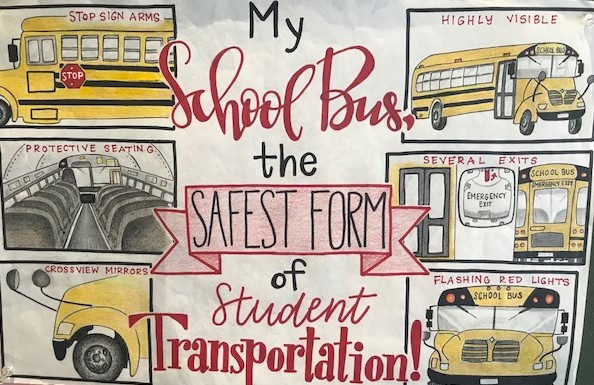
Report by Paula Antolini, October 23, 8:54PM EDT

National School Bus Safety Week is Oct. 21-25, 2019
Held during the third full week of October each year, National School Bus Safety Week is an active and evolving public education program and an excellent way for parents, students, teachers, motorists, school bus operators, school administrators, and other interested parties – to join forces and address the importance of school bus safety. Designed to promote school bus safety, school districts throughout the country observe School Bus Safety Week.

2019 National School Bus Safety Week: October 21-25, 2019 and the theme is “My School Bus, The Safest Form of Student Transportation!” The theme of National School Bus Safety Week is derived from the Poster Contest the year before. The 2018 winning poster, depicted above, was drawn by Shivangi Ojha, an 8th Grader at Belton ISD in Temple, TX.
*****
SCHOOL SAFETY TIPS
School bus transportation plays a critical role in the education of our nation’s students, and is the direct link between a neighborhood and the classroom. More than 25 million children ride the yellow bus every school day, and National School Bus Safety Week serves as a reminder for students,
parents, teachers, and the community to keep school bus safety in the forefront. Here are tips to keep our children safe at the bus stop.
Getting Ready for School
• Have your children put everything they carry in a backpack or school bag so that they won’t drop things along the way.
• Encourage them to wear bright, contrasting colors so they will be more easily seen by drivers.
• Make sure children leave home on time so they can arrive at the bus stop before it is due, ideally at least five minutes early. Running after or in front of a bus is dangerous.
Walking to the Bus Stop
• Walk young children to the bus stop or encourage children to walk in groups. There is safety in numbers; groups are easier for drivers to see.
• Practice good pedestrian behavior: walk on the sidewalk, and if there is no sidewalk stay out of the street. If you must walk in the street, walk single file, face traffic and stay as close to the edge of the road as you can.
• Stop and look left, right and then left again if you must cross the street. Do the same thing at drive -ways and alleys. Exaggerate your head turns and narrate your actions so your child knows you are looking left, right and left.
At the Bus Stop
• Have children wait in a location where the driver can see them while driving down the street. Try to avoid waiting in a house or car.
• Do not let children play in the street. Playing with balls or other toys that could roll into the street is also dangerous.
Getting On and Off the Bus
• Warn children that if they drop something getting on and off the bus, they should never pick it up. Instead, they should tell the driver and follow the driver’s instructions.
• Remind children to look to the right before they step off the bus.
• If you meet your child at the bus stop after school, wait on the side where the child will be dropped off, not across the street. Children can be so excited to see you after school that they dash across the street and forget the safety rules.
Mobile Devices
Cell phones and other electronic devices are often permitted on the school bus as long as:
• They are in backpacks or other holders, keeping hands free to use handrails while boarding and departing the bus.
• Sound is muted or headphones, ear buds or similar devices are used.
• Content does not violate the law or school district policy and procedures.
• Use does not create a distraction for the driver.
National Association for Pupil Transportation (NAPT) 800.989.6278 – [email protected] – www.napt.org
###
buy Amoxicillin
buy Vardenafil online
Pepcid no prescription
